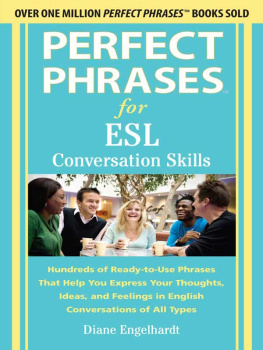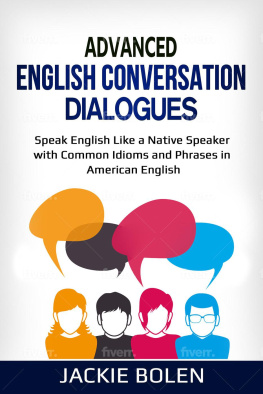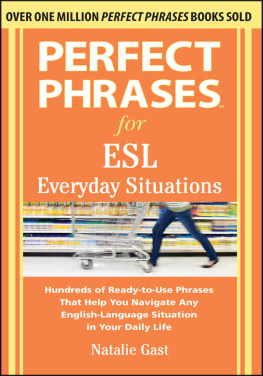PERFECT PHRASES
for
ESL
Conversation Skills
Hundreds of Ready-to-Use Phrases That Help You Express Your Thoughts, Ideas, and Feelings in English Conversations of All Types
Diane Engelhardt
New York Chicago San Francisco Lisbon London Madrid Mexico City Milan New Delhi San Juan Seoul Singapore Sydney Toronto
Copyright 2013 by Diane Engelhardt. All rights reserved. Except as permitted under the United States Copyright Act of 1976, no part of this publication may be reproduced or distributed in any form or by any means, or stored in a database or retrieval system, without the prior written permission of the publisher.
ISBN: 978-0-07-177407-9
MHID: 0-07-177407-6
The material in this eBook also appears in the print version of this title: ISBN: 978-0-07-177027-9, MHID: 0-07-177027-5.
All trademarks are trademarks of their respective owners. Rather than put a trademark symbol after every occurrence of a trademarked name, we use names in an editorial fashion only, and to the benefit of the trademark owner, with no intention of infringement of the trademark. Where such designations appear in this book, they have been printed with initial caps.
McGraw-Hill eBooks are available at special quantity discounts to use as premiums and sales promotions, or for use in corporate training programs. To contact a representative please e-mail us at .
McGraw-Hill, the McGraw-Hill Publishing logo, Perfect Phrases, and related trade dress are trademarks or registered trademarks of The McGraw-Hill Companies and/or its affiliates in the United States and other countries and may not be used without written permission. All other trademarks are the property of their respective owners. The McGraw-Hill Companies is not associated with any product or vendor mentioned in this book.
TERMS OF USE
This is a copyrighted work and The McGraw-Hill Companies, Inc. (McGrawHill) and its licensors reserve all rights in and to the work. Use of this work is subject to these terms. Except as permitted under the Copyright Act of 1976 and the right to store and retrieve one copy of the work, you may not decompile, disassemble, reverse engineer, reproduce, modify, create derivative works based upon, transmit, distribute, disseminate, sell, publish or sublicense the work or any part of it without McGraw-Hills prior consent. You may use the work for your own noncommercial and personal use; any other use of the work is strictly prohibited. Your right to use the work may be terminated if you fail to comply with these terms.
THE WORK IS PROVIDED AS IS. McGRAW-HILL AND ITS LICENSORS MAKE NO GUARANTEES OR WARRANTIES AS TO THE ACCURACY, ADEQUACY OR COMPLETENESS OF OR RESULTS TO BE OBTAINED FROM USING THE WORK, INCLUDING ANY INFORMATION THAT CAN BE ACCESSED THROUGH THE WORK VIA HYPERLINK OR OTHERWISE, AND EXPRESSLY DISCLAIM ANY WARRANTY, EXPRESS OR IMPLIED, INCLUDING BUT NOT LIMITED TO IMPLIED WARRANTIES OF MERCHANTABILITY OR FITNESS FOR A PARTICULAR PURPOSE. McGraw-Hill and its licensors do not warrant or guarantee that the functions contained in the work will meet your requirements or that its operation will be uninterrupted or error free. Neither McGraw-Hill nor its licensors shall be liable to you or anyone else for any inaccuracy, error or omission, regardless of cause, in the work or for any damages resulting therefrom. McGraw-Hill has no responsibility for the content of any information accessed through the work. Under no circumstances shall McGraw-Hill and/or its licensors be liable for any indirect, incidental, special, punitive, consequential or similar damages that result from the use of or inability to use the work, even if any of them has been advised of the possibility of such damages. This limitation of liability shall apply to any claim or cause whatsoever whether such claim or cause arises in contract, tort or otherwise.
Contents
Acknowledgments
I would first like to express my gratitude to McGraw-Hill Professional for the opportunity to publish this book and to my editor, Holly McGuire, for choosing me for this particular project.
I would also like to acknowledge the valuable insights my colleague and friend, Barb Donaldson, has provided along the way.
My thanks go out to as well to my students: Yuko, Joo-Weoun, Hye-Sin, Chae-Rin, Mayumi, and Satoko for their perceptive feedback.
Last but not least, my appreciation to my husband, Erich, for his support and encouragement.
Introduction
Who Can Benefit from Using This Book?
P erfect Phrases for ESL: Conversation Skills was written for ESL students and learners who want to improve their conversation skills inside and outside of the classroom. The content was selected to familiarize you with the kind of language native English speakers use regularly in everyday conversations and discussions at home, school, and work. Although it was written with intermediate-level speakers in mind, there is something for every motivated learner who aims to develop his or her ability to participate in conversations and discussions on a broad variety of topics.
How to Use This Book
The book consists of ten chapters divided into three parts: conversation, discussions, and special occasions. Beginning with small talk, the book progresses in depth and difficulty and concludes with an independent chapter on special occasions to round things off.
Objectives
These indicate the skills you can expect to gain from using the phrases in each chapter.
Phrases
Each chapter begins with typical conversation openers and contains a collection of topic-related phrases that will guide you through a natural conversation or discussion. Although the phrases are organized thematically, they are not exclusive to any one topic. Where appropriate, reference is made to phrases that appear in previous chapters and come in handy when you discuss different subjects.
Because language is closely tied to a countrys culture and customs, many phrases are organized from formal to informal, indirect to direct, strong to mild, and in degrees of politeness so that you can choose the phrases that are appropriate to use in different situations. The information

symbol will also alert you to language or culture tips.
You will see that some phrases and parts of phrases appear in bold type. Bold type indicates phrases that are not complete in themselves and that offer different possibilities or variations according to the subject you are discussing. For example:

I
hate / cant stand / cant stomach greasy food / waiting in long lines. ()
 Why dont you
Why dont you try doing volunteer work? ()
Phrases that are not indicated in bold type are fixed expressions and can stand on their own. For example:

What a pity! ()

I couldnt agree with you more! ()









 symbol will also alert you to language or culture tips.
symbol will also alert you to language or culture tips. I hate / cant stand / cant stomach greasy food / waiting in long lines. ()
I hate / cant stand / cant stomach greasy food / waiting in long lines. ()